Belgian WW2 Tanks and armored vehicles
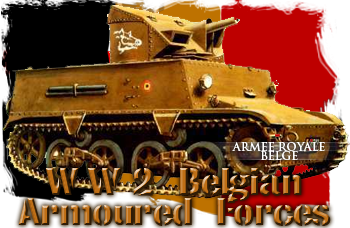
Light tanks, tank hunters and armored cars Around 360 AFVs in September 1939
Foreworld: WWI legacy
Contrary to France and UK, Belgium could not grow much experience with armored warfare, and there were several explanations for this, notably of course the occupation, and asmaller industrial basis than its powerful neighbours. Belgium was the opening chapter of this war and suffered dearly. In fact the exactions of German troops were well used as a propaganda tool by the entente powers to give more justifications to the war, the "beasty hun" was an easier for to fight if motivation was lacking. The courage, suffering and resolve of "little Belgium" was particularly well exploited in UK, for which could be otherwise seen as a continental European affair. There was also a geostrategic will to help France based on the balance of power in Europe, another traditional game played by the island nation. And of course in the end, there was the legal binding by the 1839 agreement to protect Belgium.Germany invaded neutral Belgium and Luxembourg as part of the Schlieffen Plan, in order then to turn to Paris, catching the French off guard and eliminate France, allowing the German armies to concentrate of a more numerous foe on a much larger territory, Russia. On 2 August 1914, the German government asked to be given free passage, which was refused by the Belgian government, and the invasion took place the following day at dawn, with Liège falling first, on 7 August. Belgian Army’s resistance was impressive given it was a tenth the German Army and held its territory for about a month, giving entente forces time to prepare. This played well during the Marne counteroffensive later, as the advance on Paris was on schedule. Belgian resistance in occupied territories started right away, like demolition of bridges, rail lines and of course at first, and "francs tireurs" action, was seemed illegal and subversive, and brutal retaliation followed each time, born from a frustration of such heavy resistance in the first days and amounting delays to secure objectives.
Belgium was ill-prepared for the war and her neutrality prevented any kind of coordination with France or the Netherlands. Its inexperienced general staff and compulsory service started in 1909 was born from a plan to reach 340,000 men at arms by 1926. But in 1914, Belgium lacked trained officers and sergeants and modern equipment. In all, only 102 machine guns existed between units, and there was no heavy artillery at all. By default, defence was to be fortified around Brussels, and delaying actions all along the German advance. This proved highly effective and disrupted the German timetable. Much of the army was captured early on, in and out of frontier forts and in November-December 1914 the army was reduced to 60,000 soldiers. Successes were many, like the Battle of Liège, which held off for over a week and a dead stop at the end of the "Race to the Sea" at the Battle of the Yser, a propaganda coup for Belgium. During these early operations, mobile operations relied on three elements: The Belgian cavalry, Cycliste Frontière units, and armoured cars units, which were a dependency of the latter, later sent in the Eastern front, entirely composed with the Minerva armoured car.
Eventually the Germans occupied over 95% of the country, with just a small area around Ypres remaining under Belgian control, which became static with trench warfare, like the rest of the front. Martial law was declared, the country split in two provinces, localities controlled by Kommandanturen, and the first governor appointed was Moritz von Bissing. With what the western propaganda called the "Rape of Belgium" (101 "major" incidents, 4,421 Belgians executed) perhaps 500,000 Civilians fled, mostly to France, the Netherlands and UK. There were enough later to recruit and form "free belgian" units on the western front. The next years, few volunteered to serve, enough for the pocket army to reach around 170,000. Noth enough for a major offensive, and the pocket offered little value for Germans planners, so this became a quiet sector with a killed ratio of around 2% of eligible young men until 1918, compared to 13.3% for France. Until the end of the war, King Albert I commanded the Yser front with a council of generals, but this sector was placed under Belgian supervision on this part of the flanders front.
On 28 September 1918, the Belgian Army comprised 12 infantry divisions, part of the combined Belgian-French-British "Army Group Flanders", under command of King Albert I assisted by French Chief of Staff General Jean Degoutte. They participated in the Fifth Battle of Ypres, breaching German lines at Houthulst. They conquered back Passchendaele, Langemark and Zonnebeke. From 14 October, they participated in the Battle of Courtai, liberating Bruges and Ostend and until 11 November, Battle of the Lys and Battle of Escaut eventually reached Ghent by the time of the capitulation. It was a costly move, with 1/5 of the army lost in action, 1/3 Belgian losses of the entire war.
Another forgotten aspect was Belgian Congo, which only knew some fighting at Lake Tanganyika. Congolese forces fought German colonial forces in Cameroon and seized a large portion of German East Africa up to Tabora in 1918. Also, there was a small Belgian Expeditionary Corps sent in Russia in 1915, using the only Belgian armoured unit made of Minerva armoured cars performing reconnaissance, raids and small engagements, with 16 Belgians KiA in these actions.
Belgian defensive development during the interwar
In September 1939, Belgium was not a negligible or token force. It held the seventh place in armored strength in Europe, just after Poland and the Czech Republic. This force was constricted by a limited budget, the result of the long-run 1930 financial crisis, and the fact it had to be, first and foremost, a purely defensive force, according to the "non-provocation" policy of 1936, regarding the Kingdom relations with bordering Nazi Germany. This very firm neutral position was also required to keep at bay ever-present tensions between the two very different cultural majorities of Belgium, the Walloons, related to the French, and the Flemish, culturally nearer to the Netherlands and Germany. This was accompanied, however, by energic measures, such as a 15% defense budget increase, the national service military training being stretched from 8 to 12 months and modernization of all fortifications, highly rated by military experts in 1939.Belgian armored forces were spread into several cyclist border units (notably the elite "chasseurs ardennais"), cavalry and infantry units. The fully motorized ones were supposed to act as "flying units" to defend major communications lines between five strategical strong points like the Namur and Liege forts, and above all, Eben-Emael. These thoroughly modernized fortifications -in the Maginot line style- were designed to serve as a buffer against German attacks, repelling assaults for at least five days, and at best two weeks, a delay thought long enough to allow the French and their British allies to move into place and build their own defensive line, closing the gap between the north sea and the Maginot Line itself -with the notable exception of the so-thought impassable Ardennes forest.
For these reasons, Belgium never tried to acquire or build medium tanks until 1936 -seen as an offensive or provocative gesture by the politicians. The bulk of the armored forces comprised towed AT guns, mostly those of the excellent SA-FRC (which stands for "Fonderie Royale de Canons") 47 mm (1.85 in), or modele 1931, of which over 750 were delivered to infantry and cavalry units. Tractors were of the Vickers "Utility Tractor" type, unarmed, small, stocky, of which two types largely produced, for cavalry and infantry. Their armor, equipment and speed differed accordingly.
British Vickers designs also formed the basis of the two main Belgian tanks type. The British Vickers Light Mark III was modified to give the for T15 light scout tank, while Vickers unarmored tractors where used for the construction of the T13 tank hunters, which evolved through three variants and formed the backbone of the Belgian antitank units. A handful of vintage Renault FTs were still in depots, held in reserve and scheduled for replacement with the recent ACG-1, of which only a dozen were delivered between 1937 and 1939. Articles British Vickers designs also formed the basis of the two main Belgian tanks type. The British Vickers Light Mark III was modified to give the for T15 light scout tank, while Vickers unarmored tractors where used for the construction of the T13 tank hunters, which evolved through three variants and formed the backbone of the Belgian antitank units. A handful of vintage Renault FTs were still in depots, held in reserve and scheduled for replacement with the recent ACG-1, of which only a dozen were delivered between 1937 and 1939.
Belgian forces in May 1940
In May 1940, the Belgian army could deploy 22 divisions (mostly infantry ones - 100,000 men for the standing army, 440,000 mobilized recruits in 1939, and 900,000 total with reserves in May 1940, an astonishing feat for a 8 million population) and about 200 AFVs spread into "penny packets" among divisions, and nearly 700 towed antitank guns, served either by artillery tractors, trucks or Ford-based Marmon Herrington armored cars. Total strength was only 2 fully mechanized divisions, one armored regiment and two motorized divisions. Following the Mechelen incident (a plane crash involving a German Major in Belgium, near the Meuse river), German plans detailing upcoming operations were found, and brought to the Allies. As it was, this plan called for a simple invasion trough Belgium, targeting western coast harbors, virtually repeating the 1914 Schlieffen plan. However, both King Leopold and General Raoul Van Overstraeten, his aide de camp, suspected some trick and rather firmly thought a wide encirclement using the Ardennes forest was more probable, but General Gamelin ignored the warnings and stuck to his Dyle plan. The Belgian army was supposed to hold the Antwerp - Liege - Namur line on the borders as long as possible to allow the main French forces to take positions, and withdraw afterwards to make junction with French forces, theoretically presenting a narrower front, easier to defend.The battle of Belgium - Border battles
During the first day of the invasion, German Fallschirmjäger swiftly took Eben-Emael, the cornerstone of the Belgian defense, in one of the most daring airborne operations of WWII. Not only was the Belgian deployment schedule jeopardized, but also the whole Allied defensive Dyle plan. With well coordinated attacks which took the most important objectives (bridges over the Meuse and Albert Canal), silencing fortifications around, the main offensive began.Backed by Luftwaffe's wings, Army group B quickly spearheaded through Belgium, dealing with any opposition in the process as "Fall Gelb" (case yellow) required. During the border battles of 10-11 May, the defensive lines along the Maastricht and Bois-le-Duc canal, Scheldt and Albert canal, were assaulted and partially forced through. However, the 1st Belgian Light Infantry and, later, the Belgian Ardennes Light Infantry at Bodange, both held up massive formations like the 1st Panzer Division for up to 8 hours, and the Albert Canal's west bank was held for 36 hours. After the 4th and 7th Belgian Infantry Divisions' withdrawal, the French 7th Army, failing to link up with the retreating Dutch army, turned eastwards and soon clashed into the German 9th Panzer Division at Tilburg, near Breda. Without efficient air support, they had to withdraw to Antwerp.
Later on, until 14 May, withdrawn Belgian units held Liege and Namur, executing demolition missions and delaying actions. Some of these patrols, largely equipped with T13s, scored some kills against nearly all Panzer types involved. The FRC 47 mm (1.85 in) was quite effective at medium and short range and could go through the frontal glacis of both the Panzer III and IV (30 to 50 mm/1.18-1.97 in thick). On the other hand, they fell prey to nearly all German tank and AT gun types involved -with the notable exception of the flimsy Panzer I, due to their obvious lack of armor. Despite all odds, these efforts paid off and the delaying Battle of Tirlemont and Battle of Haelen proved it. The major armored clash of the time occurred when the German VIth army launched a resolute attack into the Gembloux gap on May, 12. The area was defended by the French 1st Army and its elite armored formations. The following battle of Hannut, was the first major tank-to-tank encounter of the war. It ended with a German victory, despite appaling losses, due to superior French tanks, the latter being undone by a poor, rigid WWI style-tactical deployment.
Breakthrough at Sedan and aftermath
On May, 15, the Allies learnt German Group A had made a decisive breakthrough at Sedan, and began to make plans for a massive withdrawal from Belgium, leaving the well defended Antwerp-Namur line. The Belgian Army withdrew from Liege, which had held firm for a week, and now prepared to defend Antwerp. Antwerp and Namur offered stiff resistance until 22-23 May. However, Brussels fell on May 18, and the government fled to Oostend. By May, 20, the situation of the Belgian Army was hopeless. Despite resolute delaying actions, what was left of the armored forces was not sufficient to mount any offensive as suggested by the British BEF. King Leopold instead insisted to cover a large pocket around Belgian west coast harbors. A desperate counter-attack (the battle of Arras), unsupported by delayed French elements of the first army, failed and, quickly, a new plan was drawn, as the British army retired to the southern coast of Belgium and Dunkirk.On May, 23, the French attempted a localized counter-attack, which ended with few gains. The Belgian front was reduced to a 80 km (50 mi) long defensive line over the most southern ports covered along Yser river, around Ostend and Nieuport, still tightly linked with the BEF. On the 24th of May, the Belgian army clashed with no less than four divisions commanded by Von Bock, and managed to inflict tactical defeats on the Germans, while counter-attacking. This fighting mostly involved infantry, supported by the last towed 47 mm (1.85 in) guns, but, without air cover, their position was untenable. The Leie line were breached on the 23rd. Along with the evacuation of the first elements of the BEF at Dunkirk and the encirclement of the 1st French Army, Bruges and Ostend soon fell, after the disintegration of the remnants of an exhausted Belgian army on 27 of May. The king called for an armistice the same day. With the surrender came the capture of considerable material, at least those which had not been sabotaged beyond repairs. Subsequently, the Werhmacht took Utility B artillery tractors and T13s in quantity. Most were used for training and local defense.
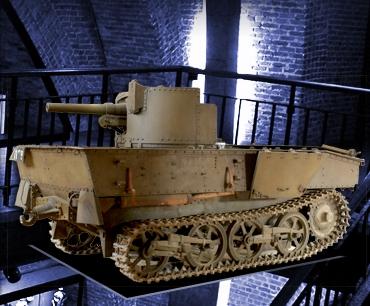
Belgian T13 B2 at the Brussels Military Museum. This is the only vehicle preserved, having served in the Régiment Cycliste de Limbourg (Regiment Grenswielrijders Limburg).
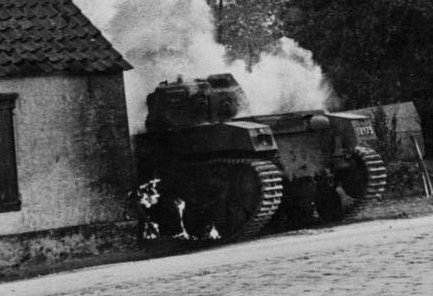
A knocked out ACG-1, burning near Antwerp - Credits: Bundesarchiv.
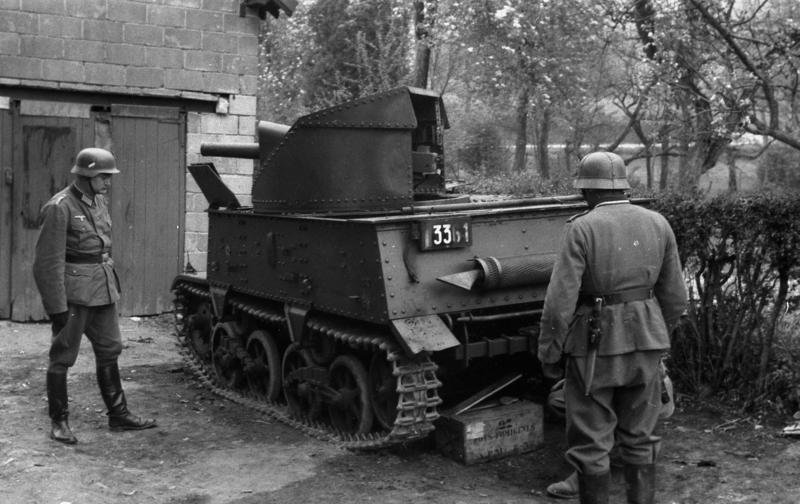
A Belgian T13 B3 belonging to the 2è Régiment de Cycliste Frontière. It was abandoned on 11 May 1941 due to problems with the engine. It was captured and is seen here being examined by German infantrymen - Credits: Bundesarchiv.
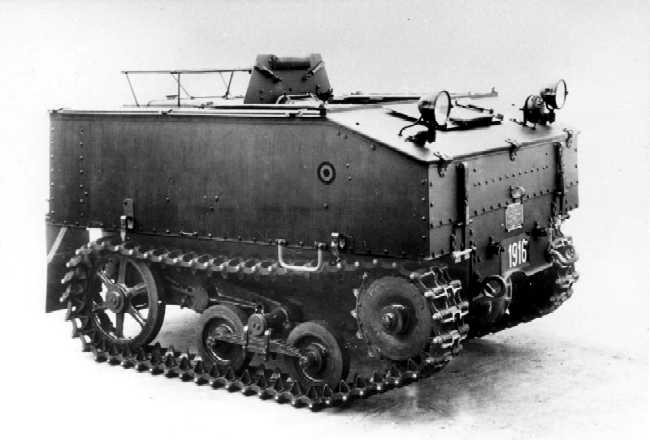
Vickers-Carden-Loyd Utility Type Infanterie. These small vehicles were the Belgian main artillery tractors in 1939.
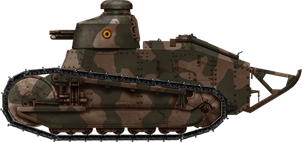
Belgian Renault FT. 75 were still held in reserve in early 1939, and replacements were on their way in the form of the ACG-1 medium tanks. This illustration is based on the Brussels army model on display at the Royal Museum of the Armed Forces in Brussels.
Light tanks
- T15 : 42 built 1936-38, based on the Vickers Light tank Mk.III. They were shipped from Great Britain with a conical turret, unarmed, and were equipped in Belgium.Infantry tanks
- Renault FT : Approximately 75 FTs were still in service by 1938, but soon placed in reserve in depots and none were active when the war broke out. They were scheduled for replacement with the French-built ACG-1.Medium tanks
- ACG-1 : 12 vehicles delivered of the 25 ordered in France. It was a variant of the AMC-35.Tank hunters
- SA FRC 47 mm gun carriers : 6 Carden-Loyd Mark VIs were converted to carry the main Belgian antitank gun, built by the "Fonderie Royale de Canons" at Liege. - T13 B1 : 35 vehicles. Equipped with a semi-traversing turret firing backwards. Same gun.- T13 B2 : 21 vehicles. Generally similar, converted using Vickers Carden Loyd model 1934 Artillery Tractors.
- T13 B3 : 250 vehicles. Completely redesigned version, with a fully traversing turret.
Armored cars
- Minerva armored car: Two vintage vehicles of Lt. Henkart's 1914 makeshift conversion, armed with a single Hotchkiss machine gun.- Ford/Marmon-Herrington armored cars: 90 vehicles built by Ford Antwerp and armored by "Rageno" at Mechelen, unarmed, but used for towing the FRC 47 mm (1.85 in) gun.
Other tracked vehicles
- VCL Utility Tractors ~ 1000 vehicles. Three unarmed types. The infantry model, with short tracks and well armored, and the cavalry model, faster and with less armor. They were used to deploy the FRC 47 mm (1.85 in) gun. - Vickers Carden Loyd model 1934 Artilery Tractors - Unknown number built. Used for the T13 conversions.
Vickers-Carden-Loyd Utility Type Infanterie. These small vehicles were the Belgian main artillery tractors in 1939.
Armored cars
- Minerva armored car: Two vintage vehicles of Lt. Henkart's 1914 makeshift conversion, armed with a single Hotchkiss machine gun. - Ford/Marmon-Herrington armored cars: 90 vehicles built by Ford Antwerp and armored by "Rageno" at Mechelen, unarmed, but used for towing the FRC 47 mm (1.85 in) gun.Other tracked vehicles
- VCL Utility Tractors ~ 1000 vehicles. Three unarmed types. The infantry model, with short tracks and well armored, and the cavalry model, faster and with less armor. They were used to deploy the FRC 47 mm (1.85 in) gun. - Vickers Carden Loyd model 1934 Artilery Tractors - Unknown number built. Used for the T13 conversions.Illustrations
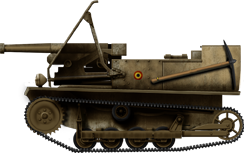 SA FRC 47 mm (1.45 in) mounted on a Carden-Loyd Mk.VI tankette. This early experiment was unsuccessful, as the hull was too light to cope with the muzzle blast and recoil of the gun. Only six were so converted. They were passed, in 1938, from the Chasseurs Ardennais to the Cycliste Frontiere regiment, and placed in fixed ambushing positions between Vivegnis and Lixhe (Meuse river western banks), firing some rounds on the Germans on 10-11 May 1940.
SA FRC 47 mm (1.45 in) mounted on a Carden-Loyd Mk.VI tankette. This early experiment was unsuccessful, as the hull was too light to cope with the muzzle blast and recoil of the gun. Only six were so converted. They were passed, in 1938, from the Chasseurs Ardennais to the Cycliste Frontiere regiment, and placed in fixed ambushing positions between Vivegnis and Lixhe (Meuse river western banks), firing some rounds on the Germans on 10-11 May 1940.



































































